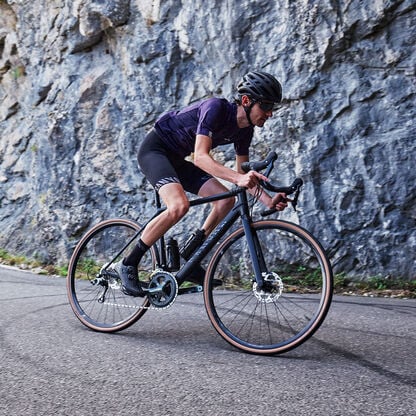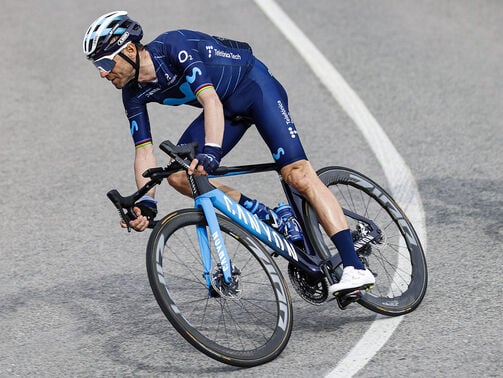Expert Guide to Gear Shifting: Road Bike Tips from Canyon Pros
It’s time to change gears … let’s talk shifting.


One of the best and easiest ways to get faster on a new Canyon road bike is to take full advantage of your shifting options.
Many newcomers shift far too infrequently or prefer to push a much harder gear, when they could be going faster with less effort. The more time you spend riding your Canyon, the more you’ll get to know the bike and its gearing. So, keep reading to learn how to shift gears like a pro and boost your road bike efficiency and performance!
Contents
Importance of proper gear shifting in road cycling
For a racer, a missed or mis-timed shift can mean the difference between a podium spot and finishing mid-pack. Your goal should be finding a gear that will allow you to put forth as much power as possible while maintaining a fast and consistent cadence. As the terrain or race conditions change, so should your gearing. If you’re a casual or long-distance cyclist, you want a gearing that will allow you to ride at a steady cadence for many hours, and, more than likely, wake up and do it again the next day. (These different cyclists might want different bikes for their needs. For more detailed information, check out our bike comparison tool.)
Understanding your bike's gearing system
Most Canyon bikes come with Shimano or SRAM drivetrains with 12-speed gearing. The 12 speeds refer to the number of rings on the rear cassette. Assuming your bike has two chainrings, the rider has 24 different gears they can use. (That number’s really 22, but that will be explained later.) Shifters on your brake levers work the front and rear derailleurs, which move the chain up and down the chain rings and cassette. (Which lever adjusts which derailleur can be country-specific.) Shifting down means your chain moves downward on the rear cog, essentially making it a harder gear to pedal. Shifting up moves your chain higher on the rear cog, making it easier to pedal.
A Shimano bike shifts differently than a SRAM bike and vice-versa. Each groupset has its own pros and cons. If you’ve never ridden a bike with one or the other groupset, try taking it for a test ride at one of Canyon’s demo centers such as the one in Carlsbad, California and test ride centers in Europe. If you feel like you’d be happier on a different model after a few rides, you can easily exchange your purchase, thanks to Canyon’s generous 30-day return policy.

Basic gear shifting techniques
To shift gears, you must be pedaling. Try to be as smooth as possible, shifting only one or two gears at a time. If riding hilly terrain or using a really fast cadence, start with the bike in the smaller chainring. The larger ring should be used primarily on flat roads and at higher speeds.
When to shift gears
When I first starting riding, one of the best pieces of advice I received was shift early and often. Shift into a harder gear when you’re looking to increase speed (say for an attack during a race) or perhaps decrease your cadence slightly. If you need to climb a hill, pedal into a headwind, increase your cadence, or ease up on your speed, shift into an easier gear. Think you might benefit from a gear change? Do it, and if it doesn’t help you, just shift back. When in doubt, choose the easier gear. Explore these effective ways to go faster on your road bike and leave your competition behind!
Avoiding cross-chaining
So why does a 12-speed bike with 24 different gear combinations actually only have 22? Shifting into the largest cog on your rear cassette while in your small ring or the smallest cog while in your biggest ring is called cross-chaining and puts unnecessary strain on your chain. It should be avoided whenever possible.
Advanced gear shifting techniques
Knowing how and when to shift pays dividends, whether you’re sprinting for a win in your local race series or trying to avoid unnecessary wear on your drivetrain. The more you ride, the more these small techniques will become engrained in your brain. Looking to elevate your other cycling skills? Check out these road bike riding techniques and tips to help you ride like a pro!
Anticipating terrain changes, climbs
The best time to shift gears is moments before you actually need to. Watch the road in front of you; if you see a hill coming up, shift into an easier gear just before your front wheel reaches the spot. When climbing, I like to keep at least one cassette cog in reserve, just so I know it’s there in case I really need it. It’s just a little mental trick that adds confidence.
Likewise, shift into an easier gear just before entering a turn so that you can start pedaling hard riding out of the apex.
Shifting while descending
One of the most common mistakes beginner cyclists make is not pedaling hard on the downhill. As soon as you crest the top of the climb, you should immediately change to a harder gear. You want to spin at a normal cadence, if possible, while feeling pressure on the pedals. (Just be sure you’re not riding too fast for your skill level, especially when encountering switchbacks.)
Maintaining cadence with gear changes
Experts suggest maintaining a cadence of about 80-100 rpms a minute for most efficiency, although most beginner riders pedal more slowly, typically 60-80 rms. It’s important to know how to adjust your cadence to account for the gear change, especially if you’re up-shifting in order to go even faster. The more you ride, the more this will become second nature.

Common gear shifting mistakes and how to avoid them
The two biggest mistakes most newer riders make when shifting is trying to dump too many gears at once or waiting too long to shift. When waiting too long to shift, say when you’re at the steepest part of the climb, you’re shifting under a heavier load, stressing your drivetrain. If you absolutely must shift, try to take a little pressure off the pedals while doing so.
Jamming through multiple cogs at once causes unnecessary wear on your cassette, which costs you both performance and money in the long term. Try to limit your shifts to one or two gears at a time.
Never shift both levers at the same time. No good can come from it, believe me.
Maintaining your gearing system for optimal performance
A clean drivetrain is also an efficient one. Apply a bicycle-specific lube regularly; once or twice a week should be sufficient for most riders. (Unless you routinely do long rides like the Movistar team, then daily.) After putting your bike in a repair stand (or simply flipping it over), move the pedals with one hand while squirting a light stream of lube across the entire length of chain. When finished, remove the excess lube with a clean rag. At least once a month, remove the rear wheel and thoroughly clean the entire drivetrain with soapy water or spray degreaser. After the grime’s removed, re-lube the chain. Properly maintained cassettes and chains should be replaced approximately every 5,000 miles (8,000 km), while abused components will last roughly half that.
If you’re riding a bike with mechanical shifting, the cables can stretch over time, which may cause the chain to skip a gear or get stuck. If that starts happening regularly, you’ll just need to replace the cables and perhaps re-index your derailleurs. Luckily, these are pretty easy tasks after you’ve done them once or twice, or you can take your bike to your local bike mechanic to do it for you.
Electronic shifting is typically smoother and can eliminate some of the issues associated with mechanical shifters. Be sure to keep an eye on your battery levels.
Pro tip: if your rear derailleur battery runs out of juice on a ride, swap it with your front derailleur battery, which typically doesn’t see as much use and probably still has charge left. (Unless, of course, you did this on a previous ride and forgot to charge them overnight.)

Discover our Road Bikes
Did this article help?
Thank you for your feedback
-
 About the author
About the authorRobert Annis
Robert Annis is an award-winning outdoor-travel journalist. As an experienced writer and sport enthusiast he writes content that is inspiring with focus on road biking. You might have read Robert's articles in Bicycling, National Geographic, Outside, Travel + Leisure, Inside Hook, AARP, Midwest Living, Sierra, Hemispheres, Departures, Lonely Planet, Afar, Los Angeles Times, Chicago Tribune, RV Magazine, and Hidden Compass.










